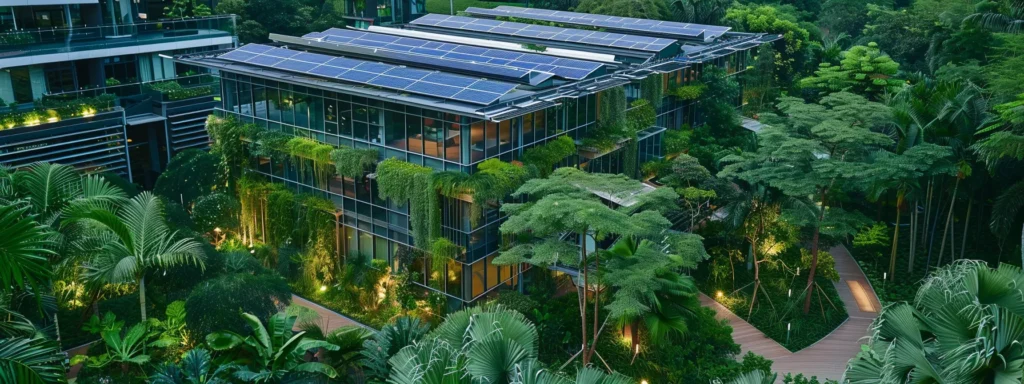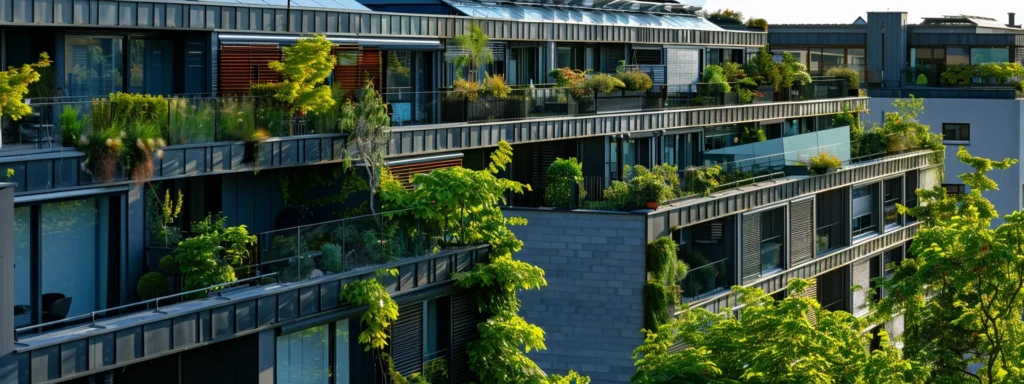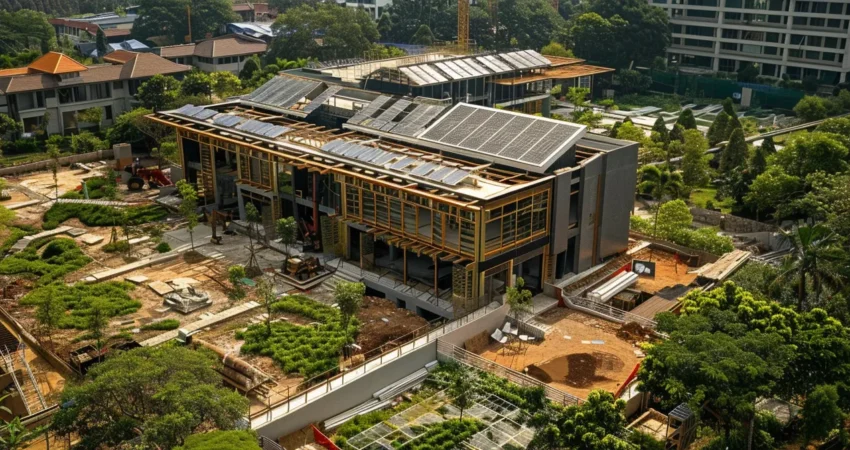- December 19, 2024
- Blacksheep Construction
Table Of Contents:
- Eco-Friendly Construction Practices: Building Towards a Sustainable Future
- Key Takeaways
- Understanding the Principles of Eco-Friendly Construction
- Selecting Sustainable Materials for Construction
- Implementing Energy-Efficient Design Strategies
- Reducing Waste and Promoting Recycling in Construction
- Leveraging Innovative Technologies for Sustainable Building
- Learning From Successful Eco-Friendly Construction Projects
- Conclusion
Eco-Friendly Construction Practices: Building Towards a Sustainable Future
Eco-friendly construction practices are essential for reducing our ecological footprint and promoting sustainable development. Did you know that construction and demolition waste accounts for nearly 40% of total waste in landfills? This blog post will explore key strategies, including selecting sustainable materials and implementing energy-efficient design, to help homeowners make informed decisions. By engaging with this content, readers will learn how to minimize waste, utilize innovative technologies, and create a more sustainable living environment. Black Sheep Construction is committed to guiding you through these practices, ensuring your projects contribute positively to the planet while addressing the challenges of plastic waste.
Key Takeaways
- Eco-friendly construction practices prioritize sustainable materials and energy efficiency for healthier living spaces
- Utilizing renewable energy sources significantly reduces reliance on fossil fuels in building projects
- Effective waste management and recycling contribute to a circular economy in the construction industry
- Community engagement enhances the success of eco-friendly infrastructure initiatives and promotes sustainability
- Advanced technologies like Building Information Modeling optimize resource use and minimize environmental impact
Understanding the Principles of Eco-Friendly Construction

Eco-friendly black sheep construction practices focus on defining the goals of sustainable building, recognizing the environmental impact of traditional construction methods, and embracing the benefits of eco-friendly techniques. This includes understanding the implications of concrete use, managing the water footprint, and optimizing heat transfer to reduce reliance on air conditioning. Aligning construction with sustainable development goals ensures a responsible approach to building for the future.
Defining the Goals of Sustainable Building Practices
Defining the goals of sustainable building practices involves a commitment to using eco-friendly building materials that minimize environmental impact. This includes selecting materials such as mycelium, which is a biodegradable option, and metal, known for its durability and recyclability. Additionally, effective management of construction waste is essential to reduce landfill contributions and promote a circular economy in the construction industry.
- Commitment to eco-friendly building materials
- Utilization of biodegradable options like mycelium
- Incorporation of durable and recyclable materials such as metal
- Effective management of construction waste
- Promotion of a circular economy in construction
Recognizing the Environmental Impact of Traditional Construction
Traditional construction methods often contribute significantly to environmental degradation, impacting both the natural landscape and indoor air quality. The use of non-sustainable materials and inefficient transport processes increases carbon emissions, while the lack of systems like rainwater harvesting leads to unnecessary water waste. By recognizing these impacts, stakeholders in architecture can adopt eco-friendly construction practices that prioritize sustainability, reduce waste, and enhance the overall health of living environments.
Embracing the Benefits of Eco-Friendly Methods
Embracing eco-friendly methods in construction offers numerous benefits that align with sustainability goals. Architects can incorporate solar power systems to harness renewable energy, significantly reducing reliance on fossil fuels. Additionally, the reuse of materials not only minimizes waste but also enhances the quality of soil and surrounding environments, creating healthier living spaces for future generations.
- Utilization of solar power for renewable energy
- Reuse of materials to minimize waste
- Improvement of soil quality and surrounding environments
- Creation of healthier living spaces
- Alignment with sustainability goals
Aligning Construction With Sustainable Development Goals
Aligning construction with sustainable development goals involves integrating renewable energy sources such as wind power and utilizing sustainable materials like bamboo. By focusing on mass timber construction and incorporating effective thermal insulation, builders can significantly reduce pollution and enhance energy efficiency. This approach not only meets current environmental standards but also contributes to a healthier planet for future generations:
- Integration of renewable energy sources like wind power
- Utilization of sustainable materials such as bamboo
- Focus on mass timber construction
- Incorporation of effective thermal insulation
- Reduction of pollution and enhancement of energy efficiency
Eco-friendly construction begins with understanding its core principles. Next, the choice of sustainable materials will shape the future of every project.
Selecting Sustainable Materials for Construction

Utilizing renewable and recycled resources is essential in selecting sustainable materials for construction. This includes choosing low-emission and non-toxic options that minimize resource depletion and protect biodiversity. Sourcing materials locally reduces transportation footprints, while evaluating the lifespan and durability of green materials ensures long-term benefits for urban design and habitat preservation.
Utilizing Renewable and Recycled Resources
Utilizing renewable and recycled resources is a cornerstone of sustainable design and sustainable architecture, significantly reducing the environmental impact of construction. For instance, using reclaimed wood for flooring not only minimizes waste but also adds character to spaces while adhering to regulations that promote eco-friendly practices. Additionally, incorporating materials that conserve drinking water, such as permeable paving, enhances the overall sustainability of a project, ensuring that builders meet both aesthetic and environmental goals.
Choosing Low-Emission and Non-Toxic Materials
Choosing low-emission and non-toxic materials is essential in the context of urbanization, as it directly impacts air pollution and the overall health of communities. For instance, selecting lumber that is certified as sustainable ensures that it comes from responsibly managed forests, reducing the strain on natural resources. Additionally, incorporating materials that support water supply conservation, such as permeable surfaces, not only enhances the sustainability of construction projects but also promotes effective recycling practices, contributing to a healthier environment for future generations.
Sourcing Locally to Reduce Transportation Footprints
Sourcing materials locally is a vital strategy in eco-friendly construction, as it significantly reduces greenhouse gas emissions associated with transportation. By utilizing innovative materials like hempcrete, builders can not only address the scarcity of traditional resources but also contribute to combating climate change. This approach not only supports local economies but also enhances the sustainability of construction projects, ensuring a more responsible use of resources.
| Strategy | Benefits | Examples |
|---|---|---|
| Sourcing Locally | Reduces greenhouse gas emissions | Hempcrete, reclaimed wood |
| Utilizing Innovative Materials | Addresses resource scarcity | Hempcrete, recycled metals |
| Supporting Local Economies | Enhances community sustainability | Local suppliers, artisans |
Evaluating the Lifespan and Durability of Green Materials
Evaluating the lifespan and durability of green materials is essential for ensuring that construction projects are both sustainable and cost-effective. Materials such as wool insulation not only provide excellent thermal performance but also contribute to energy efficiency by regulating indoor temperatures and maximizing daylight. By selecting durable resources that withstand the test of time, builders can reduce the need for frequent replacements, ultimately leading to lower environmental impact and enhanced building performance:
- Assess the longevity of materials like wool insulation.
- Consider energy efficiency and thermal performance.
- Maximize daylight to improve indoor environments.
- Choose durable resources to minimize replacements.
- Reduce overall environmental impact through informed choices.
Choosing the right materials lays the groundwork for a strong, sustainable future. Next, the focus shifts to design strategies that harness energy efficiency, shaping spaces that work with nature.
Implementing Energy-Efficient Design Strategies

Implementing energy-efficient design strategies is essential for reducing the carbon footprint of construction projects. This includes incorporating passive solar design techniques to optimize natural light and ventilation, enhancing insulation for better energy conservation, and integrating renewable energy systems such as wind power. These practices not only conserve water resources but also support a healthier ecosystem for future generations.
Incorporating Passive Solar Design Techniques
Incorporating passive solar design techniques is a vital strategy in eco-friendly construction, as it significantly reduces energy consumption and reliance on fossil fuels. By strategically positioning windows and utilizing thermal mass materials, builders can harness natural sunlight to regulate indoor temperatures, thereby minimizing greenhouse gas emissions associated with heating and cooling. This environmentally friendly approach not only enhances the comfort of the built environment but also contributes to a more sustainable future by promoting energy efficiency and reducing overall environmental impact.
Maximizing Natural Light and Ventilation
Maximizing natural light and ventilation is a critical aspect of energy-efficient design strategies in eco-friendly construction. By strategically placing windows and utilizing open floor plans, builders can significantly reduce the embodied energy associated with artificial lighting and climate control, thereby lowering the carbon dioxide emissions that contribute to the overall environmental footprint. This approach not only lessens reliance on the electrical grid but also enhances indoor air quality, creating healthier living spaces that align with sustainable building practices.
Enhancing Insulation for Better Energy Conservation
Enhancing insulation is a critical component of energy-efficient design strategies in eco-friendly construction. By utilizing advanced insulation materials, builders can significantly reduce energy loss, which is essential in combating water scarcity and minimizing the need for excessive irrigation systems. Effective insulation not only improves the performance of heating systems, such as radiators, but also aligns with sustainable building policies aimed at reducing overall energy consumption and environmental impact.
| Insulation Strategy | Benefits | Examples |
|---|---|---|
| Advanced Insulation Materials | Reduces energy loss | Spray foam, cellulose |
| Improved Heating Efficiency | Enhances radiator performance | Reflective barriers, thermal mass |
| Support for Sustainable Policies | Aligns with eco-friendly regulations | Energy Star certified products |
Integrating Renewable Energy Systems Into Buildings
Integrating renewable energy systems into buildings is a fundamental aspect of green building practices that addresses pressing environmental issues. By incorporating solar panels or wind turbines, builders can harness natural energy sources, significantly reducing reliance on traditional raw materials and fossil fuels. Additionally, utilizing materials like cork for insulation not only enhances energy efficiency but also contributes to effective stormwater management, creating a more sustainable and resilient structure that meets the needs of modern living.
Energy-efficient designs lay the groundwork for a sustainable future. Yet, the journey does not end there; reducing waste and promoting recycling in construction is the next vital step.
Reducing Waste and Promoting Recycling in Construction

Planning efficient use of materials is essential to minimize waste and reduce the risk of excess debris ending up in landfills. Reusing and recycling demolition and construction debris supports a circular economy, while adopting modular and prefabricated building components enhances resource efficiency. Additionally, managing water resources responsibly on site promotes water efficiency and contributes to sustainable practices, such as implementing green roofs.
Planning Efficient Use of Materials to Minimize Waste
Planning efficient use of materials is essential in minimizing waste during construction projects. By employing building information modeling (BIM), contractors can optimize the consumption of resources like steel and wood, ensuring that every piece is utilized effectively. This strategic approach not only reduces excess material but also supports the integration of renewable energy solutions, such as solar energy, into the design, ultimately leading to a more sustainable construction process.
| Strategy | Benefits | Examples |
|---|---|---|
| Building Information Modeling (BIM) | Optimizes resource consumption | Efficient planning of materials |
| Utilizing Steel and Wood | Reduces excess material waste | Reclaimed wood, recycled steel |
| Integrating Solar Energy | Enhances sustainability | Solar panels in design |
Reusing and Recycling Demolition and Construction Debris
Reusing and recycling demolition and construction debris is a critical component of eco-friendly construction practices, significantly contributing to climate change mitigation. By repurposing materials such as rammed earth and reclaimed wood, builders can reduce waste and minimize the environmental impact associated with new material production. This approach not only helps in preserving the landscape but also aligns with Energy Star standards, promoting energy efficiency and sustainability in construction projects.
- Utilization of rammed earth for sustainable building
- Reduction of erosion through responsible material management
- Alignment with Energy Star standards for energy efficiency
- Preservation of the landscape through recycling efforts
- Contribution to climate change mitigation strategies
Adopting Modular and Prefabricated Building Components
Adopting modular and prefabricated building components is a strategic approach in eco-friendly construction that significantly reduces waste and enhances resource efficiency. These components can be designed to optimize thermal mass, which helps regulate indoor temperatures and minimizes energy consumption, ultimately contributing to water conservation efforts. By utilizing these innovative building methods, construction projects can better align with sustainable practices while preserving the natural environment and adapting to the changing climate:
- Reduction of construction waste through efficient design.
- Optimization of thermal mass for energy efficiency.
- Support for water conservation initiatives.
- Minimization of environmental impact on the natural environment.
- Adaptation to climate change through sustainable practices.
Managing Water Resources Responsibly on Site
Managing water resources responsibly on construction sites is essential for minimizing water pollution and ensuring sustainable practices. By implementing systems such as rainwater harvesting and efficient irrigation techniques, builders can significantly reduce their carbon footprint while conserving this vital resource for future generations. Additionally, integrating renewable energy solutions into water management systems not only enhances efficiency but also supports a commitment to eco-friendly manufacturing processes, ultimately contributing to a healthier environment.
As the construction industry seeks to cut waste, new tools and methods emerge. These innovations promise not just efficiency, but a path to building sustainably for the future.
Leveraging Innovative Technologies for Sustainable Building

Implementing smart building systems enhances energy efficiency by optimizing resource use and reducing waste. Utilizing green roofs and living walls contributes to biodiversity and improves air quality. Exploring advances in sustainable building materials ensures that construction projects are environmentally responsible. Additionally, applying Building Information Modeling (BIM) facilitates eco-friendly design, streamlining the construction process while promoting sustainability.
Implementing Smart Building Systems for Efficiency
Implementing smart building systems is essential for enhancing energy efficiency in eco-friendly construction. These systems utilize advanced technology to monitor and control energy consumption, optimizing resource use and reducing waste. For instance, automated lighting and HVAC systems can adjust based on occupancy and environmental conditions, leading to significant energy savings and a lower carbon footprint, ultimately supporting sustainable building practices.
Utilizing Green Roofs and Living Walls
Utilizing green roofs and living walls in construction projects significantly enhances sustainability by improving energy efficiency and promoting biodiversity. These innovative technologies not only provide natural insulation, reducing heating and cooling costs, but also help manage stormwater runoff, contributing to urban resilience. By incorporating these features, builders can create healthier living environments that align with eco-friendly construction practices, addressing the growing need for sustainable solutions in modern architecture.
Exploring Advances in Sustainable Building Materials
Exploring advances in sustainable building materials is essential for eco-friendly construction practices. Innovations such as recycled plastics, bamboo, and hempcrete are gaining traction due to their low environmental impact and high durability. These materials not only reduce reliance on traditional resources but also contribute to energy efficiency and waste reduction, addressing the growing demand for sustainable solutions in the construction industry.
| Material | Benefits | Applications |
|---|---|---|
| Recycled Plastics | Reduces waste and conserves resources | Insulation, flooring |
| Bamboo | Fast-growing and renewable | Structural elements, flooring |
| Hempcrete | Excellent insulation and carbon-negative | Wall systems, insulation |
Applying Building Information Modeling (BIM) for Eco-Friendly Design
Applying Building Information Modeling (BIM) for eco-friendly design significantly enhances the efficiency and sustainability of construction projects. By utilizing BIM, architects and builders can create detailed digital representations of buildings, allowing for better planning and resource management. This technology enables the identification of potential waste and inefficiencies early in the design process, ultimately leading to reduced material consumption and lower environmental impact.
Innovative technologies pave the way for a new era in building. Now, let’s look at real examples of successful eco-friendly projects that show what is possible.
Learning From Successful Eco-Friendly Construction Projects

This section examines successful eco-friendly construction projects, highlighting sustainable residential developments that prioritize energy efficiency and resource conservation. It also explores green commercial buildings that exemplify innovative design and environmental responsibility. Additionally, community initiatives for eco-friendly infrastructure will be discussed, along with key takeaways and best practices derived from these real-world examples, providing valuable insights for future projects.
Case Study: Sustainable Residential Developments
Successful sustainable residential developments showcase the effectiveness of eco-friendly construction practices in creating energy-efficient homes. For instance, projects that incorporate solar panels and high-performance insulation not only reduce energy consumption but also lower utility costs for homeowners. By utilizing locally sourced materials and innovative design techniques, these developments demonstrate a commitment to sustainability while addressing the growing demand for environmentally responsible living spaces.
Case Study: Green Commercial Buildings
Green commercial buildings exemplify the successful integration of eco-friendly construction practices, showcasing innovative designs that prioritize energy efficiency and sustainability. For instance, the Bullitt Center in Seattle, often referred to as the “greenest commercial building in the world,” utilizes solar panels, rainwater harvesting systems, and sustainable materials to minimize its environmental footprint. These projects not only reduce operational costs but also enhance the well-being of occupants, demonstrating that sustainable design can lead to both economic and environmental benefits:
- Integration of solar panels for renewable energy.
- Implementation of rainwater harvesting systems.
- Use of sustainable materials to minimize environmental impact.
- Reduction of operational costs through energy efficiency.
- Enhancement of occupant well-being in green spaces.
Community Initiatives for Eco-Friendly Infrastructure
Community initiatives for eco-friendly infrastructure play a crucial role in promoting sustainable practices at the local level. Projects such as community gardens, green roofs, and rainwater harvesting systems not only enhance urban resilience but also foster a sense of community engagement. By involving residents in the planning and implementation of these initiatives, communities can effectively address environmental challenges while creating healthier living spaces that reflect their commitment to sustainability.
Key Takeaways and Best Practices From Real-World Examples
Key takeaways from successful eco-friendly construction projects highlight the importance of integrating renewable energy sources, utilizing sustainable materials, and engaging the community in the planning process. For instance, projects that incorporate solar panels and rainwater harvesting systems not only reduce operational costs but also enhance the overall sustainability of the development. By learning from these real-world examples, builders can adopt best practices that address environmental challenges while creating healthier living spaces for future generations:
| Project Type | Key Features | Benefits |
|---|---|---|
| Sustainable Residential Developments | Solar panels, high-performance insulation | Lower energy consumption, reduced utility costs |
| Green Commercial Buildings | Rainwater harvesting, sustainable materials | Minimized environmental footprint, enhanced occupant well-being |
| Community Initiatives | Community gardens, green roofs | Improved urban resilience, increased community engagement |
Conclusion
Eco-friendly construction practices play a crucial role in shaping a sustainable future by minimizing environmental impact and promoting resource efficiency. By prioritizing renewable materials, energy-efficient designs, and innovative technologies, builders can significantly reduce waste and enhance the health of living environments. Engaging in sustainable practices not only addresses pressing environmental challenges but also fosters community resilience and well-being. Embracing these principles is essential for creating a responsible and thriving built environment that benefits both current and future generations.

